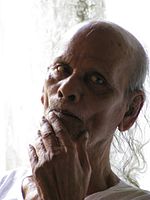| This article needs additional citations for verification. Please help improve this article by adding citations to reliable sources. Unsourced material may be challenged and removed. Find sources: "Sunamganj District" – news · newspapers · books · scholar · JSTOR (March 2012) (Learn how and when to remove this message) |
| Sunamganj District সুনামগঞ্জ জেলা | |
|---|---|
| District of Bangladesh | |
| Sunamganj District | |
     Clockwise from top-left: Pagla Jame Mosque, Kalirdeep Beel, Surma River near Jamalganj, Tanguar Haor, Tekerghat Hills Clockwise from top-left: Pagla Jame Mosque, Kalirdeep Beel, Surma River near Jamalganj, Tanguar Haor, Tekerghat Hills | |
 Location of Sunamganj District in Bangladesh Location of Sunamganj District in Bangladesh | |
| Expandable map of Sunamganj District | |
| Coordinates: 25°01′51″N 91°24′14″E / 25.030869°N 91.403761°E / 25.030869; 91.403761 | |
| Country | |
| Division | Sylhet Division |
| Headquarters | Sunamganj |
| Government | |
| • Deputy Commissioner | Mohammad Abdul Ahad |
| Area | |
| • Total | 3,747.18 km (1,446.79 sq mi) |
| Population | |
| • Total | 2,695,496 |
| • Density | 720/km (1,900/sq mi) |
| Demonym(s) | Sunamganji, Shunamgonji, Shunamgoinji |
| Time zone | UTC+06:00 (BST) |
| Postal code | 3000 |
| Area code | 0871 |
| ISO 3166 code | BD-61 |
| HDI (2019) | 0.573 medium · 20th of 20 |
| Website | www |
Sunamganj (Bengali: সুনামগঞ্জ), is a district located in north-eastern Bangladesh in the Sylhet Division.
History
In the ancient period, Sunamganj was part of the Laur Kingdom. After the conquest of Sylhet (Kingdom of Gauiurh) in 1303 by Muslims under the spiritual guidance of Shah Jalal, Shah Kamal Quhafah established a capital in Shaharpara with the aid of his twelve disciples and his second son, Shah Muazzamuddin Qureshi, who also maintained a second sub-administration office at Nizgaon on the bank of the river Surma, present day Shologhar (there is now Shologhar Masjid and madrasa) in Sunamganj town, which was administered by one of his descendants. Between the latter part of 1300 CE and 1765 CE, the present-day Sunamganj district was a part of Iqlim-e-Muazzamabad, i.e., the state of Muazzamabad, which was an independent state until 1620 when it was conquered by the mighty Mughal of Delhi. The last sultan of Muazzamabad was Hamid Qureshi Khan, who was a descendant of Shah Kamal Quhafah and he was widely known by his appellation of Shamsher Khan. After the fall of Jalalabad (present-day Sylhet), Shamsher Khan accepted the post of Nawab-cum-Fauzadar and remained so until his death at the Battle of Giria on 29 April 1740 along with Sarfaraz Khan, Nawab of Bengal.
Administration
District
The district administrator is appointed from amongst non-civil servants, usually from amongst the member of political party that is in power at the time of appointment and endorsed by the central government. The deputy commissioner is appointed from amongst career civil servants and administers all subordinate branches of the administration such as upazillah parishad Mr.Black was the first district commissioner of Sunamganj.
Subdistricts
Sunamganj District comprises 12 sub-districts or upazilas:
- Bishwamvarpur
- Chhatak
- Shantiganj
- Derai
- Dharamapasha
- Dowarabazar
- Jagannathpur
- Jamalganj
- Sullah
- Sunamganj Sadar
- Tahirpur
- Madhyanagar
During the late British colonial period, Sunamganj was a subdivision and contained six thanas; Sunamganj Sadar, Tahirpur, Chhatak (inc. Duarabazar), Derai, Jagannathpur and Dharmapasa.
Demographics
| Year | Pop. | ±% p.a. |
|---|---|---|
| 1981 | 1,428,787 | — |
| 1991 | 1,708,563 | +1.80% |
| 2001 | 2,013,738 | +1.66% |
| 2011 | 2,467,968 | +2.05% |
| 2022 | 2,695,496 | +0.80% |
| Sources: | ||
According to the 2022 Census of Bangladesh, Sunamganj District had 528,550 households and a population of 2,695,496 with an average 5.09 people per household. Among the population, 614,526 (22.80%) inhabitants were under 10 years of age. The population density was 719 people per km. The literacy rate (age 7 and over) was 64.92%, compared to the national average of 74.80%, and the sex ratio was 96.43 males per 100 females. Approximately, 14.92% of the population lived in urban areas.
| Religions in Sunamganj District (2022) | ||||
|---|---|---|---|---|
| Religion | Percent | |||
| Islam | 88.20% | |||
| Hinduism | 11.69% | |||
| Other or not stated | 0.11% | |||
| Religion | 1941 | 1981 | 1991 | 2001 | 2011 | 2022 | ||||||
|---|---|---|---|---|---|---|---|---|---|---|---|---|
| Pop. | % | Pop. | % | Pop. | % | Pop. | % | Pop. | % | Pop. | % | |
| Islam |
417,505 | 65.45% | 1,178,109 | 82.46% | 1,428,729 | 83.62% | 1,715,033 | 85.16% | 2,144,535 | 86.89% | 2,377,349 | 88.20% |
| Hinduism |
217,993 | 34.17% | 246,444 | 17.25% | 272,545 | 15.95% | 294,765 | 14.64% | 319,376 | 12.94% | 315,044 | 11.69% |
| Others | 2,399 | 0.38% | 4,234 | 0.29% | 7,289 | 0.43% | 3,940 | 0.20% | 4,057 | 0.17% | 3,103 | 0.11% |
| Total Population | 637,897 | 100% | 1,428,787 | 100% | 1,708,563 | 100% | 2,013,738 | 100% | 2,467,968 | 100% | 2,695,496 | 100% |
Muslims make up 88.20% of the population, while Hindus are 11.69% of the population. There is a minority of 2,600 Christians in the district, mainly in Madhyanagar, Tahirpur and Sunamganj Sadar upazilas. The ethnic population was 5,308, of which 2,003 were Garo and 1,506 Hudi.
Education
University
Medical College
Healthcare
The district has 12 government hospitals and 22 health centers. The infant mortality rate is 62 per 1000 child births. The average lifespan of the district's residents is 62 years.
Notable people

- A. Zahur Miah, Member of Parliament, politician
- Abdur Raees (1931-1988), former Member of Parliament in Pakistan and Bangladesh
- Abdus Samad Azad (1922-2005), former Minister of Foreign Affairs
- Anwar Choudhury (born 1959), former Governor of the Cayman Islands and High Commissioner of the UK to Bangladesh
- Apsana Begum (born 1990), Member of the British Parliament for Poplar and Limehouse
- Asaddor Ali (1929-2005), writer, researcher and historian
- Ayub Ali Master (1880-1980), social reformer in Britain
- Dewan Mohammad Azraf, educator, philosopher and National Professor of Bangladesh
- Hassan Shahriar, journalist and political analyst
- Kakon Bibi, freedom fighter, Bir Protik
- Luthfur Rahman (born 1976), deputy leader of Manchester, England
- Nazir Ahmed Chowdhury, footballer
- Shah Abdul Majid Qureshi (1915-2003), social reformer in Britain
- Shah Kamal Quhafah (1291-1385), Arab religious figure
- Shahed Ali, author and novelist
- Syeda Shahar Banu (1914-1983), language activist
- Manik Lal Ray, communist politician , Teacher pioneer of mass-education , freedom fighter
- Ramkanai Das, classical and folk musician
- Shushama Das, folk musician
- Suhasini Das, social worker and activist
- Radharaman Dutta, musician and mystic poet
- Shah Abdul Karim, musician and songwriter
- Hason Raja, musician and mystic poet
- Alaur Rahman, vocalist and music composer
- Pagol Hasan, vocalist, musician and song write
| Sunamganj District | ||
|---|---|---|
| Capital: Sunamganj | ||
| Upazilas | ||
| Constituencies | ||
| Attractions and sites | ||
| Rivers | ||
| Inhabited areas | ||
| Educational institutions | ||
| Transport | ||
| History | ||
| Barisal Division |  | |
|---|---|---|
| Chittagong Division | ||
| Dhaka Division | ||
| Khulna Division | ||
| Mymensingh Division | ||
| Rajshahi Division | ||
| Rangpur Division | ||
| Sylhet Division | ||
- Justice IMMAN Ali(Rtd)
Appellate division Supreme Court of Bangladesh.
Notes
- 1941 figures are for Sunamganj subdivision of erstwhile Sylhet district, which roughly corresponds to the present district.
- Including Jainism, Christianity, Buddhism, Zoroastrianism, Judaism, Ad-Dharmis, or not stated
References
- pmis.mopa.gov.bd/pmis/Forms/dclist.php
- ^ Population and Housing Census 2022 - District Report: Sunamganj (PDF). District Series. Dhaka: Bangladesh Bureau of Statistics. June 2024. ISBN 978-984-475-222-1.
- "Sub-national HDI - Area Database - Global Data Lab". hdi.globaldatalab.org. Retrieved 2020-03-18.
- ^ Ashfaq Hossain (2012). "Sunamganj District". In Sirajul Islam; Miah, Sajahan; Khanam, Mahfuza; Ahmed, Sabbir (eds.). Banglapedia: the National Encyclopedia of Bangladesh (Online ed.). Dhaka, Bangladesh: Banglapedia Trust, Asiatic Society of Bangladesh. ISBN 984-32-0576-6. OCLC 52727562. OL 30677644M. Retrieved 6 January 2025.
- Ali, Syed Murtaja, Hazrat Shah Jalal and Sylheter Itihas, 66: 1988
- "Cabinet Division – Bangladesh – List of the Deputy Commissioners". Cabinet.gov.bd. Archived from the original on December 22, 2011. Retrieved March 12, 2012.
- ^ "একনজরে সুনামগঞ্জ | সুনামগঞ্জ জেলা | সুনামগঞ্জ জেলা". www.sunamganj.gov.bd. Archived from the original on 2017-06-17.
- Assam District Gazetteers - Supplement. Vol. 2. Shillong. 1915. p. 26.
{{cite book}}: CS1 maint: location missing publisher (link) - ^ "Bangladesh Population and Housing Census 2011 Zila Report – Sumamganj" (PDF). Bangladesh Bureau of Statistics.
- "Census of India, 1941 Volume IX Assam Province" (PDF). 1941.
- Zahangir Alom (September 7, 2014). "Sunset Of A Music Maestro". The Daily Star.
- একুশে পদক পাচ্ছেন সুনামগঞ্জের সুষমা দাস. sunamkantha.com (in Bengali). February 14, 2017. Retrieved February 14, 2017.
- বিপ্লবী বামপন্থী মানিকদা (in Bengali).